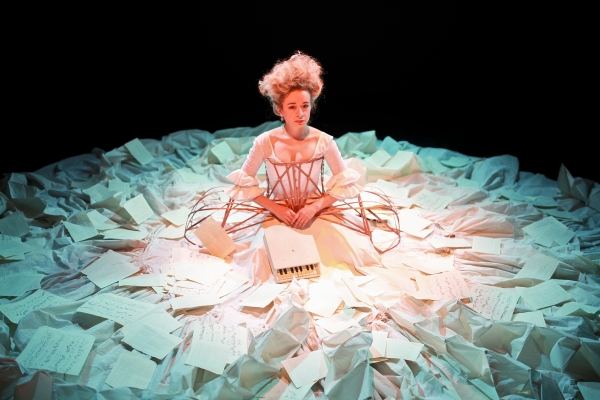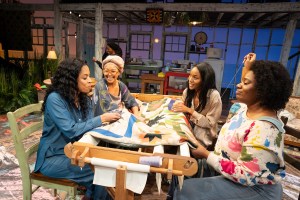The Other Mozart
Sylvia Milo tells the story of Wolfgang Amadeus Mozart’s equally talented (and internationally ignored) older sister.

(© Charlotte Dobre)
Most people are familiar with the story of Wolfgang Amadeus Mozart, the 18th-century Austrian child prodigy who played before the crowned heads of Europe and went on to compose an astounding canon of work in his relatively short life-span, much of which is still popular today. Far fewer know that in his earliest tours, he took second billing to his older sister, Marianne, who was a virtuoso in her own right. Writer and performer Sylvia Milo illuminates that relatively unknown story with her fascinating and irresistibly intelligent one-woman show, The Other Mozart, now making its New York premiere at HERE Arts Center.
Marianne, or Nannerl as her family knew her, was eight when she began taking harpsichord lessons from her Joe Jackson-like father, Leopold. Her three-year-old brother, Wolfgang, joined in the lessons, even though Leopold never allowed Nannerl to play at such a young age. Soon, the two wunderkinder were touring Europe as a double act. Yet once Nannerl was of marrying age, she was kept at home, while Wolfgang continued to perform. She eventually married a lesser nobleman and went on to live a long life in relative obscurity. Meanwhile, her brother flamed out spectacularly, but went on to be known as one of the greatest composers who ever lived.
Nannerl had her own aspiration to compose, but her parents discouraged it, considering the activity unladylike. (The violin was also off limits for girls.) Milo captures her frustrated talent in a convincing and authentic performance. Her exasperation is compounded by a didactic father, a fussbudget mother, and a ridiculously frivolous brother (whom many will recognize from Peter Shaffer's Amadeus). Milo gives voice to all of them. One is left wondering how their lives would have been different if Nannerl had the same opportunities as Wolfgang.
Interest in Nannerl has increased over the past decade; she has become the subject of several novels as well as a highly fictionalized film. Milo mostly sticks to the facts here. She has painstakingly researched the subject, drawing much of her text from the Mozart family letters. While Nannerl preserved almost all the letters her brother and father sent to her while on tour (providing an invaluable source of the knowledge we have of W.A. Mozart today), the two men didn't return the favor. "Nobody saved my letters," she shares matter-of-factly, in a moment more telling and heartbreaking than any other in the play.
Milo fills in the gaps left by these absent letters with historical context, which she excels in making frighteningly real. This is not merely a world of rococo concert halls and ridiculously coiffed hair. Milo provides lurid detail about the illness and death that lurked around every corner in 18th-century Europe, noting Nannerl's near death while on tour in London and her mother's untimely passing in Paris.
She also gives us harsh perspective on the prevailing misogyny of the day: "For a woman to aim at the sublime makes her merely ridiculous…and even worse, loathsome. She is an unbeautiful, unnatural freak who is disobeying nature and aping the genius of the male — who is her lord and master," she quotes from Immanuel Kant. A similar quote from Rousseau is not much better. If these two unapologetic sexists represented the cutting edge of "enlightened" thought in Nannerl's day, what chance did a girl have?
Still, Milo endows her subject with an irrepressible spirit that makes you root for her and hope for a better outcome. (And since we're so unfamiliar with her story in the first place, we feel that it might actually happen.) Director Isaac Byrne milks the suspense throughout, heightening it with an ever-present musical underscoring. Real work by the Mozarts meld into original compositions by Nathan Davis and Phyllis Chen: The frenetic tremolo of a harpsichord becomes the fluttering of a fan; the breaking of strings accompanies Nannerl lacing into a constrictive corset.
Milo performs the entire piece in her bloomers while prancing around a giant period dress that occupies the entire stage. Magdalena Dąbrowska and Miodrag Guberinic have constructed this one killer installation that is both a costume and set piece. It is made of the hundreds of letters the Mozarts exchanged over the years and it is beautiful. Throughout the play, Milo pulls little props from hidden nooks and crannies. Eventually, she puts the dress on, rendering her unable to move. It is an incredibly effective (if on the nose) metaphor for the societal constraint that governed Nannerl's life.
Still, very little is obvious about this play. At a brisk 75 minutes, The Other Mozart is full of surprises all the way to the end.











